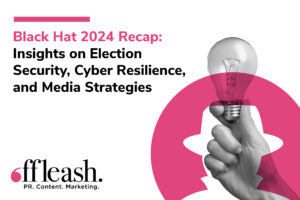Black Hat 2024 Recap: Insights on Election Security, Cyber Resilience, and Media Strategy

Each year, the Offleash cybersecurity team attends Black Hat to witness firsthand the action, energy, news, and innovation driving the industry — and this year was no exception.
The cybersecurity industry is at the forefront of addressing some of the most pressing issues of our time. Conversations at the conference centered around three key themes: election security, cyber resilience, and the shifting tides of media engagement.
Let’s dig in.
- Election Security: Managing the Threat Landscape
Election time is almost upon us, so it’s no surprise that election security took center stage at Black Hat. We can expect to see increased Distributed Denial of Service (DDoS) attacks, a common method bad actors use to disrupt online services.
However, experts reassured attendees that while these attacks could cause temporary interruptions, they are unlikely to influence or change election outcomes. Vote counting and tallying systems are typically isolated from the internet, providing a strong defense against such threats.
There was also buzz around how AI — particularly generative AI (GenAI) — technologies might be exploited by cybercriminals during election season. The core message remained clear: Ensuring the integrity of the democratic process requires not only preventing disruptions but also swiftly identifying and neutralizing any interference attempts in order to maintain public confidence in the electoral system.
In a continued effort to enhance digital security, Apiiro introduced its new Risk Detection at Design Phase capability, designed to mitigate security and compliance risks before code is written. Additionally, Code42 (now part of Mimecast) unveiled new protections to safeguard against data exfiltration due to GenAI tools, enabling organizations to safely leverage the technology while keeping corporate IP secure.

- Cyber Resilience: Lessons from the CrowdStrike Outage
Much of the discourse at Black Hat was — of course — about the recent CrowdStrike IT outage. Although this incident wasn’t the result of a cyberattack, it demonstrated just how disruptive a global outage can be, highlighting the critical need for increased cyber resilience and collaboration. During the keynote, Cybersecurity and Infrastructure Security Agency (CISA) Director Jen Easterly referred to the outage as a “useful exercise” in assessing the resiliency of critical infrastructure organizations.
The outage has prompted a renewed focus on building resilient systems and ensuring that critical infrastructure remains operational, even during crises. In this spirit of heightened collaboration and collective strength, the cybersecurity community is more united than ever. Rubrik announced a new partnership and technology integration with Mandiant, and Cribl announced four strategic partnerships with Vijilan Security, Anvilogic, Securonix, and Anomali.

- The Shifting Media Landscape: New Ways to Engage
Finally, the changing dynamic of conferences and media engagement was evident at this year’s event. Despite the fact that Black Hat drew 20,000 in-person attendees, ongoing challenges within the media industry have led to a noticeable decline in media presence.
To more effectively connect with the media who were attending, vendors put on events that allowed for a more personal experience (think banquet dinners, happy hours, roundtable discussions, and networking parties) in lieu of doing all their networking on the show floor. For example, Descope co-sponsored a networking and cocktail reception and Code42 (now part of Mimecast) co-hosted a cybersecurity breakfast.
These smaller, more intimate events allowed vendors, attendees, and reporters alike to connect on a more personal level, fostering deeper relationship-building. It’s a trend we can expect to see more of as the media landscape continues to diminish.
Our team was proud to represent nine of our cybersecurity clients at this year’s conference, cheering them on as they continue to contribute to the industry’s innovation and transformation. There’s no telling how the threat landscape will evolve in the coming year, but one thing is sure: Cyber resilience must stay a top priority, and collaboration will be essential for securing the future.
